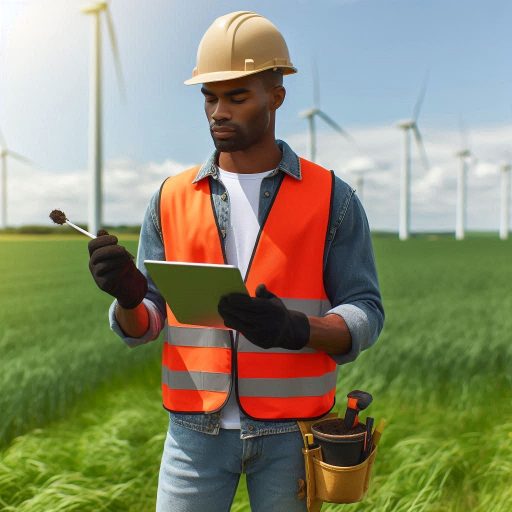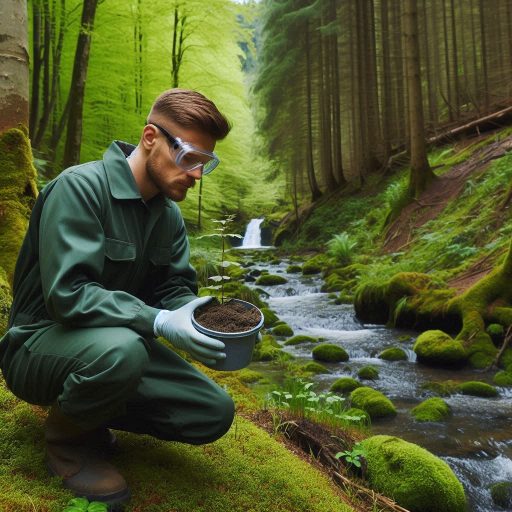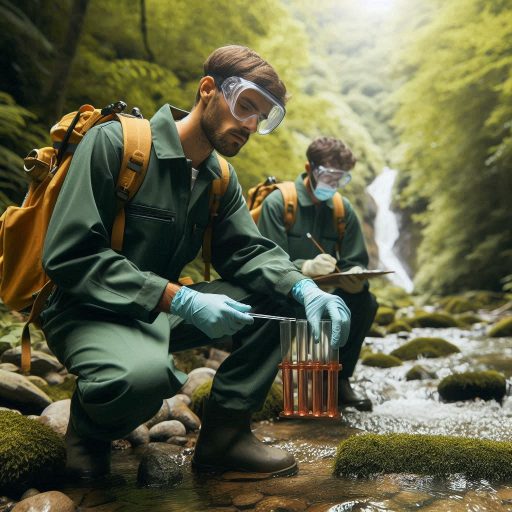Introduction
An environmental technician plays a crucial role in monitoring and protecting the environment.
Environmental technicians collect samples, conduct tests, and analyze data to assess environmental conditions.
Importance of Their Role
Their work helps to identify potential hazards, prevent pollution, and ensure compliance with environmental regulations.
Overview of a Typical Day
A typical day for an environmental technician starts with reviewing monitoring plans and preparing equipment for fieldwork.
They then head out to different sites to collect samples, which may include air, water, soil, or hazardous materials.
These samples are carefully collected and labeled to avoid contamination.
Back in the lab, technicians analyze the samples using various testing methods such as chemical analysis, microscopy, and spectrometry.
The data gathered is then interpreted and compiled into reports for regulatory agencies or clients.
In addition to fieldwork and lab analysis, environmental technicians also conduct site assessments, investigate environmental incidents, and participate in environmental clean-up projects.
Overall, their work is essential in safeguarding the environment and promoting sustainability.
Morning Routine
I start my day by waking up early in the morning to get ready for work.
After freshening up, I have a healthy breakfast to fuel me for the day ahead.
I make sure to pack my lunch and fill up my reusable water bottle.
Equipment Check and Preparation for the Day
Before heading out, I double-check all my equipment to ensure everything is in working order.
I pack my sampling kits, safety gear, and any other tools required for the day’s tasks.
I also review the schedule and tasks for the day to mentally prepare for what lies ahead.
Travel to Job Site or Office
I hop into my company vehicle and drive to the job site, enjoying the morning scenery.
During the commute, I mentally prepare and go over the tasks I need to accomplish.
Once I arrive at the site or office, I park my vehicle and gather all my equipment.
Safety Briefing and Review of Tasks for the Day
I attend a safety briefing conducted by my team leader to ensure everyone is aware of potential hazards.
We review the tasks for the day, emphasizing the importance of following safety protocols.
After the briefing, I head out to start my day as an environmental technician.
Read: Impact of Drones on Surveying and Mapping
Fieldwork tasks
As an environmental technician, my day typically starts with fieldwork tasks which involve going out to different sites to conduct surveys and collect data.
Conducting environmental surveys and data collection
One of the key responsibilities of my job is to conduct environmental surveys to assess the impact of human activities on the environment.
This involves collecting data on air quality, water quality, soil composition, and other environmental indicators.
Sampling air, water, or soil for analysis
In order to gather accurate data, I collect samples of air, water, and soil for analysis in the laboratory.
This helps us to assess the level of pollution in a particular area and determine the potential risks to human health and the environment.
Identifying potential hazards and risks in the environment
By analyzing the samples collected from the field, I am able to identify potential hazards and risks in the environment.
This information is crucial for developing effective strategies to mitigate the impact of pollution and other environmental threats.
Collaborating with team members on projects
As part of a team of environmental professionals, I collaborate with my colleagues on various projects.
This involves sharing data, analyzing results, and developing recommendations for environmental management and conservation.
In general, a day in the life of an environmental technician is both challenging and rewarding.
From conducting fieldwork tasks to collaborating with team members on projects, every day presents new opportunities to make a positive impact on the environment.
By conducting surveys, collecting data, sampling air, water, and soil for analysis, and identifying potential hazards and risks, environmental technicians play a crucial role in safeguarding our planet for future generations.
Read: Top Surveying and Mapping Technician Employers
Laboratory Work
As an environmental technician, a significant portion of my day is spent in the laboratory conducting various tests and analyses on samples collected in the field.
These laboratory tasks are crucial in determining the quality of the environment and identifying potential issues that need addressing.
Sample Preparation
One of the first steps in laboratory work is sample preparation.
This involves carefully handling and processing the samples to ensure their integrity and reliability for analysis.
It is essential to follow strict protocols to prevent contamination and maintain accuracy.
Instrumentation
Once the samples are prepared, I utilize a range of advanced instrumentation to conduct tests.
This equipment includes spectrophotometers, chromatographs, and other specialized tools that allow me to analyze the samples for various parameters such as pollutants, contaminants, and environmental indicators.
Analyzing Samples Collected in the Field
Before conducting any tests in the laboratory, I collect samples from different environmental sources such as air, water, soil, and biological materials.
These samples are carefully collected using appropriate techniques to ensure representative and accurate results.
Field Sampling
Field sampling involves going out to different locations to collect environmental samples.
This can be a challenging task due to varying conditions and accessibility issues.
It is crucial to follow established protocols to obtain samples that are suitable for laboratory analysis.
Transform Your Career Today
Unlock a personalized career strategy that drives real results. Get tailored advice and a roadmap designed just for you.
Start NowTransportation and Storage
After collecting samples, they need to be properly transported and stored to prevent any degradation or contamination.
Special care is taken to maintain the integrity of the samples during transportation to the laboratory, where they will undergo analysis.
Conducting Tests and Interpreting Results
In the laboratory, I conduct a series of tests on the samples to determine their composition, concentration of pollutants, and other key parameters.
These tests help in understanding the impact of environmental factors on the quality of air, water, and soil.
Test Protocols
Each test follows specific protocols and procedures to ensure consistency and reliability of results.
This includes calibrating instruments, setting up control samples, and running replicates to validate the accuracy of the tests.
Interpretation of Results
Once the tests are completed, I analyze the data and interpret the results to draw conclusions about the environmental quality.
This involves comparing the results with regulatory standards and guidelines to assess compliance and identify any potential risks or issues.
Documenting Findings and Preparing Reports
After analyzing the samples and interpreting the results, I document my findings and prepare detailed reports that summarize the findings.
These reports are essential for communicating the environmental status to stakeholders and regulatory authorities.
Report Writing
Report writing involves summarizing the methodology, results, and conclusions in a clear and concise manner.
It is important to use technical language that is understandable to the intended audience, whether it is a government agency, private company, or the general public.
Recommendations
In addition to documenting the findings, I often provide recommendations for mitigating any issues identified during the analysis.
These recommendations may include remediation strategies, monitoring plans, or policy changes that can help improve the environmental quality in a given area.
Maintaining Accuracy and Consistency in Data Analysis
Throughout the process of data collection, testing, and reporting, it is crucial to maintain accuracy and consistency in data analysis.
This ensures that the results are reliable and can be used for making informed decisions about environmental management and protection.
Quality Control
Quality control measures are implemented at every step of the data analysis process to verify the accuracy and precision of the results.
This includes running control samples, monitoring instrument performance, and adhering to established quality assurance procedures.
Data Validation
Before finalizing any reports or conclusions, I validate the data to ensure that it is consistent and free of errors.
This involves cross-checking results, verifying calculations, and addressing any anomalies or outliers that may affect the validity of the findings.
By following these procedures and adhering to strict quality standards, I can confidently provide accurate and reliable information on the environmental conditions in a given area.
Read: Safety Tips for Field Surveying Technicians

Client Interactions
Environmental technicians play a crucial role in managing and maintaining environmental health.
Much of their work involves interacting with clients to understand their needs and concerns.
This interaction starts with an initial meeting where technicians gather detailed information about the project.
They ask questions to clarify the client’s objectives and specific requirements.
This helps in tailoring the environmental solutions to meet the client’s expectations.
Effective communication skills are essential here.
Technicians must convey technical information in a clear and understandable manner, ensuring the client feels confident in the technician’s expertise.
Communicating Results and Recommendations to Clients
Once the data is collected and analyzed, technicians need to communicate their findings to the clients.
This involves preparing detailed reports that outline the results of environmental assessments.
Technicians present these reports in a way that highlights key findings and actionable recommendations.
They use straightforward language and visual aids to make complex data more accessible.
During these presentations, technicians also provide recommendations for improvements or corrective actions.
It is important that clients fully understand these suggestions and how they will impact their operations or environment.
Addressing Questions or Concerns from Stakeholders
Clients and other stakeholders often have questions or concerns about environmental assessments.
Technicians must be prepared to address these inquiries thoroughly and promptly.
This might involve explaining technical details, discussing implications of the findings, or clarifying how recommendations will be implemented.
Addressing concerns effectively helps build trust and ensures that all parties are on the same page.
Technicians must be patient and willing to provide detailed explanations.
This helps reassure stakeholders that their environmental issues are being handled professionally and effectively.
Providing Guidance on Environmental Regulations and Compliance
Environmental technicians also play a key role in guiding clients on regulatory compliance.
They must be well-versed in current environmental regulations and standards.
Technicians advise clients on how to meet these regulations and ensure their operations comply with legal requirements.
They help interpret complex legal language and apply it to specific situations.
Providing this guidance is crucial for avoiding potential fines or legal issues.
Technicians also keep clients updated on any changes in regulations that may affect their operations.
Building Relationships with Clients for Future Projects
Building and maintaining strong relationships with clients is essential for future projects.
Technicians strive to establish trust through consistent, high-quality work and open communication.
By understanding clients‘ needs and providing valuable insights, technicians position themselves as reliable partners.
They follow up after project completion to address any further questions or issues.
This ongoing engagement helps secure future opportunities and fosters long-term partnerships.
Good relationships with clients can lead to repeat business and referrals, contributing to the technician‘s professional growth and success.
Read: Recent Trends in Surveying and Mapping Technologies
Learn More: Importance of Technical Skills in Industrial Mechanics
Continuing Education and Professional Development
As an environmental technician, staying current with industry trends is crucial for career growth.
Transform Your Career Today
Unlock a personalized career strategy that drives real results. Get tailored advice and a roadmap designed just for you.
Start NowAttending training sessions or workshops is a common practice to update knowledge and skills.
These sessions cover topics such as new regulations, emerging technologies, and best practices.
By staying informed, technicians can perform their duties more effectively and efficiently.
Pursuing Certifications or Licenses
Many environmental technicians pursue certifications or licenses to enhance their skills and credibility.
These certifications demonstrate a commitment to professionalism and expertise in the field.
Examples include Certified Environmental Professional (CEP) or Hazardous Waste Operations and Emergency Response (HAZWOPER).
Having these credentials can open doors to new job opportunities and career advancements.
Networking with Other Professionals
Networking is essential for environmental technicians to build connections and learn from others in the industry.
Attending conferences, joining professional organizations, and participating in online forums are ways to network.
Interacting with peers allows technicians to share experiences, seek advice, and stay motivated in their careers.
Building a strong professional network can lead to collaborations, mentorships, and future job prospects.
Seeking Opportunities for Career Advancement
Environmental technicians should always be on the lookout for ways to advance their careers.
This may involve seeking out projects with more responsibility, pursuing higher education, or taking on leadership roles.
By continuously challenging themselves and setting goals, technicians can progress in their careers and achieve success.
Staying proactive and adaptable in a constantly evolving field is key to long-term career growth.
Read: Field vs. Office Work in Surveying and Mapping
Uncover the Details: Certifications for Industrial Engineers
Delve into the Subject: Certifications for Aerospace Engineers
Challenges faced by environmental technicians
As an environmental technician, there are a variety of challenges that we face on a daily basis.
These challenges can range from dealing with unpredictable weather conditions to balancing multiple projects and deadlines.
Let’s take a look at some of the challenges faced by environmental technicians:
Dealing with Unpredictable Weather Conditions
- One of the biggest challenges environmental technicians face is the unpredictability of weather conditions.
- Working outdoors means having to deal with rain, snow, extreme heat, and other weather challenges.
- This can make it difficult to plan and carry out fieldwork effectively, leading to delays and setbacks.
Adapting to New Technologies and Tools
- Environmental technology is constantly evolving, requiring technicians to adapt to new tools and techniques.
- Keeping up with the latest technologies can be challenging, but it is essential for staying ahead in the field.
- Learning how to use new equipment and software can take time and effort, but it is necessary for efficient work.
Balancing Multiple Projects and Deadlines
- Environmental technicians often juggle multiple projects and deadlines at the same time.
- Managing different tasks simultaneously can be overwhelming and stressful.
- Setting priorities, creating schedules, and staying organized are key to meeting deadlines and delivering quality work.
Managing Stress and Maintaining Work-Life Balance
- The nature of environmental work can be demanding, leading to stress and burnout.
- Finding a healthy work-life balance is crucial for maintaining overall well-being and productivity.
- Practicing self-care, setting boundaries, and seeking support when needed can help environmental technicians manage stress effectively.
In review, being an environmental technician comes with its own set of challenges.
From dealing with unpredictable weather conditions to managing stress and maintaining work-life balance, environmental technicians must be resilient and adaptable.
By facing these challenges head-on and developing strategies to overcome them,
environmental technicians can thrive in their field and make a positive impact on the environment.
Transform Your Career Today
Unlock a personalized career strategy that drives real results. Get tailored advice and a roadmap designed just for you.
Start NowConclusion
Recap of the Key Responsibilities and Tasks of an Environmental Technician
An environmental technician plays a crucial role in maintaining ecological balance and ensuring compliance with environmental regulations.
Their day-to-day activities include monitoring air and water quality, conducting soil tests, and managing waste disposal.
They collect and analyze samples to detect pollutants and assess environmental conditions.
These professionals often operate and calibrate specialized equipment and instruments to gather accurate data.
Regular site inspections and reporting are essential parts of their job.
They also collaborate with other environmental specialists to develop and implement strategies for environmental protection and improvement.
Overall, their work involves a mix of fieldwork and data analysis, each critical to safeguarding the environment.
Emphasis on the Rewarding Aspects of the Job
The role of an environmental technician offers significant rewards beyond just a paycheck.
One of the most fulfilling aspects of this career is the direct impact on environmental conservation and public health.
By detecting pollutants and addressing environmental issues, technicians contribute to a cleaner, safer planet.
Their work helps prevent environmental damage and promotes sustainability, benefiting communities and future generations.
Moreover, the job provides a sense of accomplishment from solving complex problems and witnessing the positive effects of their efforts.
Many environmental technicians find satisfaction in their ability to make tangible improvements to the world around them, fostering both personal and professional fulfillment.
Encouragement for Those Interested in Pursuing a Career in Environmental Science
For individuals passionate about protecting the environment, becoming an environmental technician can be a rewarding career choice.
This field offers diverse opportunities and the chance to work on impactful projects.
It combines scientific knowledge with practical problem-solving skills, making it ideal for those interested in both science and hands-on work.
A career in environmental science also opens doors to various specializations, such as wildlife conservation or pollution control.
If you have a strong interest in environmental issues and enjoy working outdoors, pursuing a role as an environmental technician could be a great fit.
Consider gaining relevant education and experience to prepare for this fulfilling career path.
Call-to-Action for Readers to Learn More About Environmental Technician Roles
If you‘re intrigued by the idea of working as an environmental technician, take the next step to explore this career further.
Research educational requirements, industry certifications, and potential job opportunities in your area.
Reach out to professionals in the field for insights and advice on how to get started.
Numerous resources and organizations offer information about environmental technician roles and the skills needed to succeed.
By learning more about this career path, you can make an informed decision and embark on a journey that contributes positively to the environment.
Start your research today and consider how you can become part of this essential field.
[E-Books for Sale]
The Big Book of 500 High-Paying Jobs in America: Unlock Your Earning Potential
$19.99 • 500 High-Paying Jobs • 330 pages
Explore 500 high-paying jobs in America and learn how to boost your career, earn more, and achieve success!
See All 500 High-Paying Jobs of this E-Book
1001 Professions Without a Degree: High-Paying American Jobs You Can Start Now
$19.99 • 1001 Professions Without a Degree • 174 pages
Discover 1001 high-paying jobs without a degree! Unlock career tips, skills, and success strategies for just $19.99!




